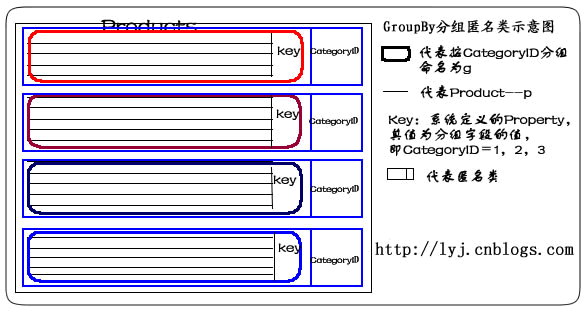Group By/Having操作符
适用场景:分组数据,为我们查找数据缩小范围。
说明:分配并返回对传入参数进行分组操作后的可枚举对象。分组;延迟
1.简单形式:var q = from p in db.Products group p by p.CategoryID into g select g;
语句描述:使用Group By按CategoryID划分产品。
说明:from p in db.Products 表示从表中将产品对象取出来。group p by p.CategoryID into g表示对p按CategoryID字段归类。其结果命名为g,一旦重新命名,p的作用域就结束了,所以,最后select时,只能select g。当然,也不必重新命名可以这样写:
var q = from p in db.Products group p by p.CategoryID;
我们用示意图表示:
如果想遍历某类别中所有记录,这样:
foreach (var gp in q) { if (gp.Key == 2) { foreach (var item in gp) { //do something } } }2.Select匿名类:var q = from p in db.Products group p by p.CategoryID into g select new { CategoryID = g.Key, g };
说明:在这句LINQ语句中,有2个property:CategoryID和g。这个匿名类,其实质是对返回结果集重新进行了包装。把g的property封装成一个完整的分组。如下图所示:
如果想遍历某匿名类中所有记录,要这么做:
foreach (var gp in q) { if (gp.CategoryID == 2) { foreach (var item in gp.g) { //do something } }}
3.最大值var q = from p in db.Products group p by p.CategoryID into g select new { g.Key, MaxPrice = g.Max(p => p.UnitPrice) };
语句描述:使用Group By和Max查找每个CategoryID的最高单价。
说明:先按CategoryID归类,判断各个分类产品中单价最大的Products。取出CategoryID值,并把UnitPrice值赋给MaxPrice。
4.最小值var q = from p in db.Products group p by p.CategoryID into g select new { g.Key, MinPrice = g.Min(p => p.UnitPrice) };
语句描述:使用Group By和Min查找每个CategoryID的最低单价。
说明:先按CategoryID归类,判断各个分类产品中单价最小的Products。取出CategoryID值,并把UnitPrice值赋给MinPrice。
5.平均值var q = from p in db.Products group p by p.CategoryID into g select new { g.Key, AveragePrice = g.Average(p => p.UnitPrice) };
语句描述:使用Group By和Average得到每个CategoryID的平均单价。
说明:先按CategoryID归类,取出CategoryID值和各个分类产品中单价的平均值。
6.求和var q = from p in db.Products group p by p.CategoryID into g select new { g.Key, TotalPrice = g.Sum(p => p.UnitPrice) };
语句描述:使用Group By和Sum得到每个CategoryID 的单价总计。
说明:先按CategoryID归类,取出CategoryID值和各个分类产品中单价的总和。
7.计数var q = from p in db.Products group p by p.CategoryID into g select new { g.Key, NumProducts = g.Count() };
语句描述:使用Group By和Count得到每个CategoryID中产品的数量。
说明:先按CategoryID归类,取出CategoryID值和各个分类产品的数量。
8.带条件计数var q = from p in db.Products group p by p.CategoryID into g select new { g.Key, NumProducts = g.Count(p => p.Discontinued) };
语句描述:使用Group By和Count得到每个CategoryID中断货产品的数量。
说明:先按CategoryID归类,取出CategoryID值和各个分类产品的断货数量。 Count函数里,使用了Lambda表达式,Lambda表达式中的p,代表这个组里的一个元素或对象,即某一个产品。
9.Where限制var q = from p in db.Products group p by p.CategoryID into g where g.Count() >= 10 select new { g.Key, ProductCount = g.Count() };
语句描述:根据产品的―ID分组,查询产品数量大于10的ID和产品数量。这个示例在Group By子句后使用Where子句查找所有至少有10种产品的类别。
说明:在翻译成SQL语句时,在最外层嵌套了Where条件。
10.多列(Multiple Columns)var categories = from p in db.Products group p by new { p.CategoryID, p.SupplierID } into g select new { g.Key, g };
语句描述:使用Group By按CategoryID和SupplierID将产品分组。
说明:既按产品的分类,又按供应商分类。在by后面,new出来一个匿名类。这里,Key其实质是一个类的对象,Key包含两个Property:CategoryID、SupplierID。用g.Key.CategoryID可以遍历CategoryID的值。
11.表达式(Expression)var categories = from p in db.Products group p by new { Criterion = p.UnitPrice > 10 } into g select g;
语句描述:使用Group By返回两个产品序列。第一个序列包含单价大于10的产品。第二个序列包含单价小于或等于10的产品。
说明:按产品单价是否大于10分类。其结果分为两类,大于的是一类,小于及等于为另一类。

